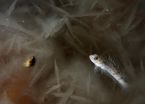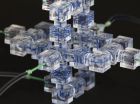(Press-News.org) Manufacturing biofuels from food crop by-products such as straw could be made quicker and cheaper thanks to the work of scientists in the UK and France.
Researchers funded by the Biotechnology and Biological Sciences Research Council (BBSRC) have discovered variant straw plants whose cell walls are more easily broken down to make biofuels, but which are not significantly smaller or weaker than regular plants.
The discovery could help ease pressure on global food security as biofuels from non-food crops become easier and cheaper to make.
The impact of carbon emissions on global warming is driving the need for carbon neutral biofuels. Many existing biofuels are produced from crops which can be used for food, and therefore have a negative impact on global food security.
One answer is to make fuels from woody, non-food parts of plants such as straw. These are rich in polysaccharides (sugar chains) which can be broken down into simple sugars and then fermented into ethanol for fuel.
However, such biofuels are currently too expensive because of the cost of digesting the woody tissues into simple sugars.
Researchers in the Centre for Novel Agricultural Products at the University of York led by Professor Simon McQueen-Mason, working with colleagues in France, screened a large collection of variants of the model grass species Brachypodium for digestibility.
Screening variants in this way allows rapid assessment of the range of natural diversity that can be found in a species.
Using this approach, PhD student Poppy Marriott identified 12 independent plant lines with highly digestible straw, but which grew normally and showed no decrease in straw strength.
Analysing these plants showed that increased digestibility can be achieved through a range of changes in the cell wall, where the majority of sugar is contained in woody biomass.
In addition the team at York also showed they can identify the gene alterations that give rise to the high digestibility.
The new results are published in the latest edition of the Proceedings of the National Academy of Sciences USA.
By identifying these plant variants with straw that is easier to digest, but which retain their size and strength, the cost and complexity of biofuel production could be reduced.
Professor McQueen-Mason said: "This work sets the stage for identifying similar high-digestibility lines in commercial crop species that will pave the way to more cost-effective and sustainable biofuels.
"Using plant by-products such as straw provides a double benefit as we can harvest the food from the plant, then use the straw to produce a carbon neutral fuel."
Professor Melanie Welham, BBSRC Executive Director for Science, said: "This research is another important step towards making carbon-neutral biofuels both easier and cheaper to produce. Using crop by-products such as straw for biofuels reduces pressure on food supplies and also adds value to the crop, boosting food security and helping farmers.
"It is just one example of how BBSRC investment in world class bioscience is working towards addressing some of the existing and emerging global challenges that we all face."
INFORMATION:
Contact: Chris Melvin, BBSRC Media Officer, 01793 414694, chris.melvin@bbsrc.ac.uk
David Garner, Head of Media Relations University of York, 01904 322153, david.garner@york.ac.uk
Reference: A range of cell wall alterations enhance saccharification in Brachypodium distachyon mutants is published in Proceedings of the National Academy of Sciences USA.
About BBSRC
The Biotechnology and Biological Sciences Research Council (BBSRC) invests in world-class bioscience research and training on behalf of the UK public. Our aim is to further scientific knowledge, to promote economic growth, wealth and job creation and to improve quality of life in the UK and beyond.
Funded by Government, BBSRC invested over £484M in world-class bioscience in 2013-14. We support research and training in universities and strategically funded institutes. BBSRC research and the people we fund are helping society to meet major challenges, including food security, green energy and healthier, longer lives. Our investments underpin important UK economic sectors, such as farming, food, industrial biotechnology and pharmaceuticals.
For more information about BBSRC, our science and our impact see: http://www.bbsrc.ac.uk
For more information about BBSRC strategically funded institutes see: http://www.bbsrc.ac.uk/institutes
About the Centre for Novel Agricultural Products (CNAP)
The Centre for Novel Agricultural Products (CNAP) is an award winning strategic research centre based in the Department of Biology at the University of York. CNAP is dedicated to realising the potential of plants as renewable, low-cost factories that produce high-value chemicals and biofuels. Laboratory based discoveries are translated into practice in partnership with industry. http://www.york.ac.uk/org/cnap/
Plant variants point the way to improved biofuel production
2014-09-22
ELSE PRESS RELEASES FROM THIS DATE:
Study: Antifreeze proteins in Antarctic fishes prevent freezing…and melting
2014-09-22
CHAMPAIGN, Ill. — Antarctic fishes that manufacture their own "antifreeze" proteins to survive in the icy Southern Ocean also suffer an unfortunate side effect, researchers report: The protein-bound ice crystals that accumulate inside their bodies resist melting even when temperatures warm.
The finding is reported in the Proceedings of the National Academy of Sciences.
"We discovered what appears to be an undesirable consequence of the evolution of antifreeze proteins in Antarctic notothenioid fishes," said University of Oregon doctoral student Paul Cziko, who led ...
Healthy lifestyle choices may dramatically reduce risk of heart attack in men
2014-09-22
WASHINGTON (Sept. 22, 2014) — Following a healthy lifestyle, including maintaining a healthy weight and diet, exercise, not smoking and moderating alcohol intake, could prevent four out of five coronary events in men, according to a new study publishing today in the Journal of the American College of Cardiology.
While mortality from heart disease has declined in recent decades, with much of the reduction attributed to medical therapies, the authors said prevention through a healthy lifestyle avoids potential side effects of medication and is more cost effective for population-wide ...
Immune response turned up, not down, by flu during pregnancy, Stanford/Packard study finds
2014-09-22
Pregnant women have an unusually strong immune response to influenza, an unexpected finding that may explain why they get sicker from the flu than other healthy adults, new research from the Stanford University School of Medicine and Lucile Packard Children's Hospital Stanford has found.
The results were surprising because immune responses are thought to be weakened by pregnancy to prevent the woman's body from rejecting her fetus.
The study, which will be published online Sept. 22 in the Proceedings of the National Academy of Sciences, is the first to examine the ...
Firelight talk of the Kalahari Bushmen
2014-09-22
SALT LAKE CITY, Sept. 22, 2014 – After human ancestors controlled fire 400,000 to 1 million years ago, flames not only let them cook food and fend off predators, but also extended their day.
A University of Utah study of Africa's Kalahari Bushmen suggests that stories told over firelight helped human culture and thought evolve by reinforcing social traditions, promoting harmony and equality, and sparking the imagination to envision a broad sense of community, both with distant people and the spirit world.
Researchers previously studied how cooking affected diets and ...
University of Utah engineers unlock potential for faster computing
2014-09-22
SALT LAKE CITY, Sept. 22, 2014 – University of Utah engineers discovered a way to create a special material – a metal layer on top of a silicon semiconductor – that could lead to cost-effective, superfast computers that perform lightning-fast calculations but don't overheat.
This new "topological insulator" behaves like an insulator on the inside but conducts electricity on the outside and may pave the way for quantum computers and fast spintronic devices.
The research, led by University of Utah materials science and engineering professor Feng Liu, was published today ...
Lego-like modular components make building 3-D 'labs-on-a-chip' a snap
2014-09-22
Thanks to new LEGO®-like components developed by researchers at the USC Viterbi School of Engineering, it is now possible to build a 3-D microfluidic system quickly and cheaply by simply snapping together small modules by hand.
Microfluidic systems are used in many fields including engineering, chemistry and biotechnology to precisely manipulate small volumes of fluids for use in applications such as enzymatic or DNA analysis, pathogen detection, clinical diagnostic testing, and synthetic chemistry. Traditionally, microfluidic devices are built in a cleanroom on a two-dimensional ...
Platelets modulate clotting behavior by 'feeling' their surroundings
2014-09-22
Platelets, the tiny cell fragments whose job it is to stop bleeding, are very simple. They don't have a cell nucleus. But they can "feel" the physical environment around them, researchers at Emory and Georgia Tech have discovered.
Platelets respond to surfaces with greater stiffness by increasing their stickiness, the degree to which they "turn on" other platelets and other components of the clotting system, the researchers found.
"Platelets are smarter than we give them credit for, in that they are able to sense the physical characteristics of their environment and ...
Genetic switch regulates a plant's internal clock based on temperature
2014-09-22
Scientists have discovered a key molecular cog in a plant's biological clock – one that modulates the speed of circadian (daily) rhythms based on temperature.
Transcription factors, or genetic switches, drive gene expression in plants based on external stresses – such as light, rain, soil quality, or even animals grazing on them. A team of researchers at USC has isolated one, called FBH1, that reacts to temperature – tweaking the rhythm here and there as needed while in keeping it on a consistent track.
"Temperature helps keep the hands of the biological clock in the ...
Massachusetts General study reveals gene expression patterns in pancreatic CTCs
2014-09-22
Analysis of circulating tumor cells (CTCs) in a mouse model of pancreatic cancer identified distinct patterns of gene expression in several groups of CTCs, including significant differences from the primary tumor that may contribute to the ability to generate metastases. In their study reported in the Sept. 25 issue of Cell Reports, investigators from the Massachusetts General Hospital (MGH) Cancer Center identified several different classes of pancreatic CTCs and found unexpected factors that may prove to be targets for improved treatment of the deadly tumor.
"Our ...
Infant solar system shows signs of windy weather
2014-09-22
Astronomers using the Atacama Large Millimeter/submillimeter Array (ALMA) have observed what may be the first-ever signs of windy weather around a T Tauri star, an infant analog of our own Sun. This may help explain why some T Tauri stars have disks that glow weirdly in infrared light while others shine in a more expected fashion.
T Tauri stars are the infant versions of stars like our Sun. They are relatively normal, medium-size stars that are surrounded by the raw materials to build both rocky and gaseous planets. Though nearly invisible in optical light, these disks ...






